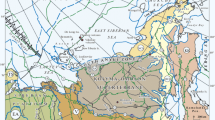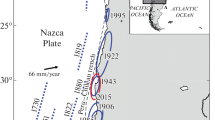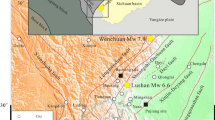Abstract
This study is concerned with Western and Central Tien-Shan. It is an area of intracontinental collision and is of great interest for the study of the geodynamic processes that are occurring in the crust. The area of study was investigated using the method of seismotectonic deformation (STD). The STD was calculated on the basis of the approaches proposed by Yu.V. Riznichenko and S.L. Yunga. We used the ISC (International Seismological Centre, London) catalog for estimating the seismicity distribution, for calculating the mean annual rate of STD (STD intensity) IΣ, and the parameter of concentration of earthquake-generating ruptures KСР. The catalog includes over 84 000 earthquakes for the period 1902–2019. The distribution of the parameters mentioned above was calculated for three depth ranges: 0–5, 5–25, and over 25 km. We identified areas of intensive seismotectonic deformation, seismic activity, and high concentration of earthquake-generating faults. The study of the entire earthquake-generating layer gave the result that the maximum STD intensity IΣ = ~9 × 10–8 yr–1 was obtained for the junction zone between Southern Tien-Shan and Northern Pamirs. As to the north part of the area of study, high values of STD intensity were obtained for the western Terskey Alatau: IΣ = ~2 × 10–9 yr–1. At all the depths studied here, the maximum rate of earthquakes occurs in the Gissar-Kokshaal earthquake-generating zone. In the northern part, high seismicity is characteristic for the mountain ranges that encircle the Issyk Kul Basin (Terskey Alatau, Kungei Alatau, and Zailiisky Range). The area of study typically exhibits a high level of the concentration of earthquake-generating ruptures, with most of these lying at depths of 0–5 km. Our study of STD directivity is based on data for focal mechanisms of 11 376 earthquakes occurring in 1949–2020. We plotted diagrams showing the distribution of azimuthal directions for the principal stress axes. The azimuth of the compression axis for most events falls within the sector 300°–360°. The resulting STD maps were inspected to determine the directions of shortening and lengthening axes, and to note that the deformation settings show a great diversity in the area of study. The STD tensors obtained for the depths 5–25 km (the earthquake-generating layer) were used to find the distributions of the Lode–Nadai coefficient με, of the sum of the horizontal components (ХХ + YY), and of the vertical component (ZZ). We determined areas that show simple compression and maximum shortening. The models of crustal deformation derived by the STD method and from GPS data were compared to find a fairly good consistency.











Similar content being viewed by others
Notes
Yunga, S.L., A Study of Crustal Movements and Deformations in Central Tien Shan, the Kazakh Platform, and Altai; Develo** a Program for Processing of Seismological Data, the Processing Carried out, A research report, Obninsk, 2002. 41 p.
REFERENCES
Abdrakhmatov, K.E., Wildon, R., Thompson, S., et al., The origin, direction, and rate of present-day compression in central Tien Shan, Kirgizia, Geol. Geofiz., 2001, vol. 42, no. 10, pp. 1585–1610.
Burtman, V.S., Tyan-Shan i Vysokaya Aziya (Tien Shan and High Asia), Moscow: GEOS, 2012.
Chediya, O.K., Morfostruktury i noveishii tektogenez Tyan-Shanya (The Morphostructures and Neotectonic Tectogenesis of Tien Shan), Frunze: Ilim, 1986.
International Seismological Centre, On-line Bulletin, 2019. Available from: http://www.isc.ac.uk (last accessed 10.06.2020).
Kalmetieva, Z.A., Kostyuk, A.D., and Sycheva, N.A., On relationships between landslides and earthquakes, Izv. NAN KR, Bishkek: Ilim, 2010, no. 4, pp. 22–29.
Kostyuk, A.D., Sycheva, N.A., Yunga, S.L., et al., Crustal; deformation in Tien Shan based on earthquake mechanisms and space geodesy, Fizika Zemli, 2010, no. 3, pp. 52–65.
Krestnikov, V.N., Shishkin, E.I., Shtange, D.V., and Yunga, S.L., The state of stress in the crust of Central and Northern Tien Shan, Izv. AN SSSR, Fizika Zemli, 1987, no. 3, pp. 13–30.
Kuchai, O.A. and Bushenkova, N.A., Focal mechanisms of Central Tien Shan, Fiz. Mezomekh., 2009, vol. 12, no. 1, pp. 17–24.
Kurskeev, A.K., Zemletryaseniya i seismicheskaya bezopasnost Kazakhstana (Earthquakes and the Seismic Safety of Kazakhstan), Almaty: Evero, 2004.
Kuzikov, S.I. and Mukhamediev, Sh.A., The structure of the present-day crustal movement rates in the area of the Central Asia GPS network, Fizika Zemli, 2010, no. 7, pp. 33–51.
Lukk, A.A., Shevchenko, V.I., and Leonova, V.G., Autonomous geodynamics of the Pamir–Tien Shan junction zone from seismology data, Physics of the Solid Earth, 2015, vol. 51(6), pp. 859–877.
Lukk, A.A. and Shevchenko, V.I., Seismicity, tectonics, and GPS geodynamics of the Caucasus, Izv., Physics of the Solid Earth, 2019, vol. 55(4), pp. 626–648.
Lukk, A.A. and Yunga, S.L., The seismotectonic deformation in the Garm area, Izv. AN SSSR, Fizika Zemli, 1979, no. 10, pp. 24–43.
Makarov, V.I., Noveishaya tektonicheskaya struktura Tsentralnogo Tyan-Shanya (The Neotectonic Structure of Central Tien Shan), Moscow: Nauka, 1977.
Mamyrov, E., Omuraliev, M., and Usupaev, Sh.E., Otsenka veroyatnoi seismicheskoi opasnosti territorii Kyrgyzskoi Respubliki I prigranichnykh raionov stran Tsentralnoi Azii na period 2002–2005 gg. (Assessment of Probable Earthquake Hazard to the Territory of the Kyrgyz Republic and Adjacent Areas of Countries in Central Asia for the Period 2002–2005), Bishkek, 2002.
Mansurov, A.N., A continuum model of present-day crustal deformation in the Pamir-Tien Shan region constrained by GPS data, Russian Geology and Geophysics, 2017, vol. 58, no. 7, pp. 787–802. https://doi.org/10.1016/j.rgg.2017.06.002
Midi, B. Dzh. and Khager, B.Kh., The present-day distribution of deformation in western Tien Shan using block models based on geodetic data, Geol. Geofiz., 2001, vol. 42, no. 10, pp. 1622–1633.
Rebetsky, Yu.L., Tektonicheskie napryazheniya i prochnost' prirodnykh massivov (Tectonic Stresses and the Strength of Natural Rock Massifs), Moscow: Akademkniga, 2007.
Rebetsky, Yu.L. and Alekseev, R.S., The field of recent tectonic stresses in Central and South-Eastern Geodyn. Tectonophys., Asia, 2014, vol. 5(1), pp. 257–290. https://doi.org/10.5800/GT-2014-5-1-0127
Rebetsky, Yu. L., Sycheva, N.A., Kuchay, O.A., and Tatevossian, R.E., Development of inversion methods on fault slip data. Stress state in orogenes of the central Asia, Tectonophysics, 2012, vol. 581, pp. 114–131. https://doi.org/10.1016/j.tecto.2012.09.027
Rebetsky, Yu.L., Sycheva, N.A., Sychev, V.N., et al., Crustal stresses in Northern Tien Shan based on data from the KNET network, Geol. Geofiz., 2016, vol. 57, no. 3, pp. 496–520.
Reigber, C., Michel, G.W., Galas, R., et al., New space geodetic constraints on the distribution of deformation in central Asia, Earth Planet. Sci. Lett., 2001, vol. 191(1–2), pp. 157–165. https://doi.org/10.1016/S0012-821X(01)00414-9
Riznichenko, Yu.V., The source dimensions of the crustal earthquakes and the seismic moment, in Issledovaniya po fizike zemletryasenii (Studies in Earthquake Physics), Moscow: Nauka, 1976, pp. 9–27.
Riznichenko, Yu.V., Problemy seismologii (Problems in Seismology), Moscow: Nauka, 1985.
Sadybakasov, I., Neotektonika Vysokoi Azii (The Neotectonics of High Asia), Moscow: Nauka, 1990.
Search form, Global CMT Catalog Search. URL: https://www.globalcmt.org/CMTsearch.html (date of request: June 12, 2020).
Shults, S.S., Analiz noveishei tektoniki i relief Tyan-Shanya (An Analysis of Neotectonics and Relief of Tien Shan), Moscow: Geografgiz, 1948.
Sobolev, G.A. and Zav’yalov, A.D., On the concentration criterion of earthquake-generating ruptures, Dokl. AN SSSR, 1980, vol. 252, no. 1, pp. 69–71.
Sovremennaya geodinamika oblastei vnutrikontinentalnogo kollizionnogo goroobrazovaniya (Tsentralnaya Aziya) (Present-Day Geodynamics of Areas of Intracontinental Collisional Orogenesis: Central Asia), Moscow: Nauchnyi Mir, 2005.
Sycheva, N.A., Seismic moment tensor and dynamic parameters of earthquakes in the Central Tien Shan, Geosistemy perekhodnykh zon (Geosystems of Transition Zones), 2020, vol. 4, no. 2, pp. 192–209. (In Engl.). https://doi.org/10.30730/gtrz.2020.4.2.178-191.192-209
Sycheva, N.A. and Mansurov, A.N., Comparing the estimates of crustal deformation for northern and central Tien Shan based on GPS and seismic data, Vestnik KRSU, 2016, vol. 16, no. 1, pp. 178–182.
Sycheva, N.A. and Mansurov, A.N., Comparing the estimates of crustal deformation at the Bishkek Geodynamic Test Site based on seismological and GPS data, Geodin. Tektonof., 2017, vol. 8, no. 4, pp. 809–825.
Sycheva, N.A. and Mansurov, A.N., Seismotectonic deformation of the lithosphere in the Pamir and adjacent territories, Geodyn. Tectonophys., 2020, vol. 11(4), pp. 785–805. https://doi.org/10.5800/GT-2020-11-4-0507
Sycheva, N.A., Yunga, S.L., Bogomolov, L.M., et al., Crustal seismotectonic deformations in the Issyk Kul zone and in the Kazakh Tien Shan, in Aktivnyi geofizicheskii monitoring litosfery Zemli (Active Geophysical Monitoring of the Earth’s Lithosphere), Novosibirsk, 2005, pp. 344–350.
Sycheva, N.A., Yunga, S.L., Bogomolov, L.M., and Mukhamadeeva, V.A., Crustal seismotectonic deformations in northern Tien Shan: Determinations of earthquake source mechanisms based on data from the KNET digital seismic network, Fizika Zemli, 2005a, no. 11, pp. 62–78.
Sycheva, N.A., Bogomolov, L.M., Yunga, S.L., and Makarov, V.I., Seismotectonic deformations and the neotectonics of Tien Shan, Fizika Zemli, 2008, no. 5, pp. 3–15.
Trifonov, V.G., Soboleva, O.V., Trifonov, R.V., and Vostrikov, G.A., Sovremennaya geodinamika Alpiisko-Gimalaiskogo kollizionnogo poyasa (The Present-Day Geodynamics of the Alpine–Himalayan Collisional Belt), Moscow: GEOS, 2002.
Trofimov, A.K., Udalov, N.F., Utkina, N.G., et al., Geologiya kainozoya Chuiskoi vpadiny i ee gornogo obramleniya (The Cenozoic Geology of the Chu Basin and Its Mountainous Circumference), Leningrad: Nauka, 1976.
Vinnik, L., Reigber, C., Aleshin, I., et al., Receiver function tomography of the central Tien Shan, Earth Planet. Sci. Lett., 2004, vol. 225(1–2), pp. 131–146. doi.org/https://doi.org/10.1016/j.epsl.2004.05.039
Yudakhin, F.N., Geofizicheskie polya, glubinnoe stroenie i seismichnost Tyan-Shanya (Geophysical Fields, Deep Structure, and Seismicity in Tien Shan), Frunze: Ilim, 1983.
Yudakhin, F.N., Chediya, O.K., Sabitova, T.M., et al., Sovremennaya geodinamika litosfery Tyan-Shanya (The Present-Day Geodynamics of the Tien Shan Lithosphere), Moscow: Nauka, 1991.
Yunga, S.L., Metody i rezul’taty izucheniya seismotektonicheskikh deformatsii (Methods for and Results from Studies of Seismotectonic Deformation), Moscow: Nauka, 1990.
Yunga, S.L., On the classification of seismic moment tensors based on their isometric imaging onto a sphere, Dokl. Akad. Nauk, 1997, vol. 352, no. 2, pp. 253–255.
Zav’yalov, A.D., Srednesrochnyi prognoz zemletryasenii (Intermediate-Term Earthquake Prediction), Moscow: Nauka, 2006.
Zubovich, A.V. and Mukhamediev, Sh.A., A method of superimposed triangulations for calculation of velocity gradient of horizontal movements: application to the Central Asian GPS network, Geodyn. Tectonophys., 2010, vol. 1, no. 2, pp. 169–185.
Zubovich, A.V., Trapeznikov, Yu.A., Bragin, V.D., et al., The deformation field, deep crustal structure, and the spatial distribution of seismicity in Tien Shan, Geol. Geofiz., 2001, vol. 42, no. 10, pp. 1634–1640.
Zubovich, A.V., Beisenbaev, R.T., Van Syaochin, et al., The present-day kinematics of the Tarim–Tien-Shan–Altai region in Central Asia: GPS measurements, Fizika Zemli, 2004, no. 9, pp. 31–40.
Zubovich, A.V., Wang, X., Scherba, Y.G., et al., GPS velocity field for the Tien Shan and surrounding regions, Tectonics, 2010, 29(6), TC6014. https://doi.org/10.1029/2010TC002772
ACKNOWLEDGMENTS
I am grateful to Artur Mansurov who lent me use his results from the calculation of present-day crustal strain rate tensor based on GPS observations.
Funding
This work was supported in part by a state assignment at the Research Station of the Russian Academy of Sciences, Bishkek (research topics AAAA-A19-119020190064-9 and AAAA-A19-119020190066-3).
Author information
Authors and Affiliations
Corresponding author
Additional information
Translated by A. Petrosyan
Rights and permissions
About this article
Cite this article
Sycheva, N.A. Crustal Seismotectonic Deformations in Central and Western Tien-Shan. J. Volcanolog. Seismol. 15, 414–434 (2021). https://doi.org/10.1134/S0742046321060105
Received:
Revised:
Accepted:
Published:
Issue Date:
DOI: https://doi.org/10.1134/S0742046321060105




